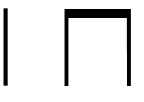Y2. Lesson 5. Practise the minim [too]
Prior learning: Minim [too]
Duration: 30 minutes
Materials:
Keywords: Beat, rhythm, singing, chanting, partners, rhymes, circle games.
Difficulty: ![]()
Prepare
Present
Practise
The minim [too]
 Melodic development
Melodic development
![]() Students answer how many notes are in the phrase sung by the teacher.
Students answer how many notes are in the phrase sung by the teacher.
- Students are seated and attentive.
- Sing Good Morning using a combination of between two and four pitches.
- Ask the class how many sounds were present.
- Ask for a show of hands for the answer, and students should respond with the correct number of pitches.
- Sing again with a student's name and a different combination of pitches. The student should respond with the correct answer.
- Ask the students how many sounds they heard.
- Repeat with other students as time permits.
 Rhythmic development
Rhythmic development
![]() Students sight sing to two familiar classroom songs.
Students sight sing to two familiar classroom songs.
- Students are seated and attentive.
- Project the first score and ask students the name of the song [See-Saw].
- Sing the first two notes and ask again.
- Receiving a correct answer, point to each note as you sing the song.
- Ask a student to come forward and point to each note as the class sings.
- Ask the class to sing the solfa.
- Then ask the class to sing the time names.
- When secure, repeat the process with the second song [Bounce High].
 Creative movement
Creative movement
![]() Students sing and perform actions to the beat.
Students sing and perform actions to the beat.
- Students take a partner and hold hands.
- Lead the class in singing Bluebells.
- Students should move their joined arms up and down to the beat.
- On the first words, 'evee, ivee, over,' students turn back-to-back.
- The second time those words are sung, students turn again to face each other.
- Students must quickly find a new partner at the song's end, and the game recommences.
 Listening
Listening
![]() Students discover more about this famous piece of music.
Students discover more about this famous piece of music.
- Students should have heard this piece from prior lessons.
- Play the music on the player and stop after a few seconds.
- Ask students the name of the music and who composed it.
- Ask the class to sing the rhythm pattern using ta, ti-ti and za time names.
- Ask the class about the loudness and softness of the music. What happened during the song [it became louder and louder].
- Ask the class about the tempo of the song. Did it change? [It became faster and faster].
- Did the music get higher or lower in pitch from the beginning?
 Visual learning
Visual learning
![]() Students discover how to write the minim [too] using both stick and traditional notation.
Students discover how to write the minim [too] using both stick and traditional notation.
- Project the graphic on the board.
- Lead the class in singing Here Comes A Magpie.
- Sing the second phrase, pointing to each note in turn on the board.
- Ask students which symbol on the board lasts for two beats.
- Remind students that a note lasting for two beats has a time name, too.
- Draw the minim [too], explaining that it consists of an empty notehead with a stem.
- Explain that the second phrase is written on the top line using stick notation and on the bottom line with traditional notation.
- Ask students to write the phrase in their notebooks.
 Instruments
Instruments
![]() Students discover how to play a known classroom song using tuned percussion.
Students discover how to play a known classroom song using tuned percussion.
- Distribute glockenspiels and marimbas (or similar classroom instruments) and divide the class into two groups.
- Teach the first phrase on the glockenspiel and ask the group with that instrument to copy you.
- Teach the first phrase on the marimba and ask the group with that instrument to copy you.
- When secure ask both groups to play on your command and conduct the class.
- Repeat the process with the next phrases, and use your judgment on how far or how fast the class is progressing.
- This exercise may take two or more learning periods to become secure.
 Part work
Part work
![]() Students use an ostinato pattern and hand signs.
Students use an ostinato pattern and hand signs.
- Divide the class into two groups.
- Write an ostinato pattern on the board [example given].

- Group 1 sings Bell Horses with solfège syllables and hand signs, and Group 2 taps a rhythmic ostinato that is read from notation.
- When secure, swap the two groups around.
Students section

 Assess
Assess
Suggested lessons
Y1. Beat II

Y1. Beat III

Y1. Beat IV


